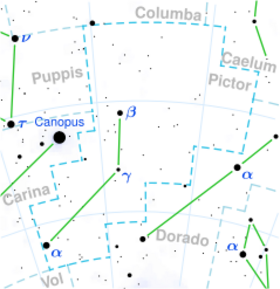Astronomy:HD 42540
From HandWiki
Short description: Star in the constellation Pictor
| Observation data Equinox J2000.0]] (ICRS) | |
|---|---|
| Constellation | Pictor |
| Right ascension | 06h 07m 03.40671s[1] |
| Declination | −62° 09′ 16.4496″[1] |
| Apparent magnitude (V) | 5.04[2] |
| Characteristics | |
| Spectral type | K2-3III[3] |
| U−B color index | +1.35[4] |
| B−V color index | +1.25[4] |
| Variable type | suspected[5] |
| Astrometry | |
| Radial velocity (Rv) | +21.60[6] km/s |
| Proper motion (μ) | RA: +15.513[1] mas/yr Dec.: −70.013[1] mas/yr |
| Parallax (π) | 8.378 ± 0.0939[1] mas |
| Distance | 389 ± 4 ly (119 ± 1 pc) |
| Absolute magnitude (MV) | −0.18[2] |
| Details | |
| Mass | 2.8[7] M☉ |
| Radius | 27[7] R☉ |
| Luminosity | 270[1] L☉ |
| Temperature | 4,530[8] K |
| Rotational velocity (v sin i) | 1.7[9] km/s |
| Other designations | |
| Database references | |
| SIMBAD | data |
HD 42540, also known as HR 2196, is a giant star in the constellation Pictor. A class K2-3III orange giant, its apparent magnitude is 5.04 and it is approximately 389 light years away based on parallax.
This star was mistakenly catalogued as Mu Doradus (Mu Dor/μ Doradus/μ Dor) at incorrect coordinates, then assumed to be variable as no 5th-magnitude star was seen at that position. It also has the Gould designation 47 G. Pictoris.[10]
References
- ↑ 1.0 1.1 1.2 1.3 1.4 1.5 Vallenari, A. et al. (2022). "Gaia Data Release 3. Summary of the content and survey properties". Astronomy & Astrophysics. doi:10.1051/0004-6361/202243940 Gaia DR3 record for this source at VizieR.
- ↑ 2.0 2.1 Anderson, E.; Francis, Ch. (2012). "XHIP: An extended hipparcos compilation". Astronomy Letters 38 (5): 331. doi:10.1134/S1063773712050015. Bibcode: 2012AstL...38..331A. Vizier catalog entry
- ↑ Hoffleit, D.; Warren, W. H. (1995). "VizieR Online Data Catalog: Bright Star Catalogue, 5th Revised Ed. (Hoffleit+, 1991)". VizieR On-line Data Catalog: V/50. Originally Published in: 1964BS....C......0H 5050. Bibcode: 1995yCat.5050....0H.
- ↑ 4.0 4.1 Mermilliod, J. C. (2006). "VizieR Online Data Catalog: Homogeneous Means in the UBV System (Mermilliod 1991)". VizieR On-line Data Catalog: II/168. Originally Published in: Institut d'Astronomie 2168. Bibcode: 2006yCat.2168....0M.Vizier catalog entry
- ↑ Watson, Christopher (18 January 2010). "NSV 2845". AAVSO Website. American Association of Variable Star Observers. http://www.aavso.org/vsx/index.php?view=detail.top&oid=41469. Retrieved 24 May 2014.
- ↑ Wilson, R. E. (1953). "General Catalogue of Stellar Radial Velocities". Carnegie Institute Washington D.C. Publication (Carnegie Institution for Science). Bibcode: 1953GCRV..C......0W.
- ↑ 7.0 7.1 Kervella, Pierre; Arenou, Frédéric; Thévenin, Frédéric (20 December 2021). "Stellar and substellar companions from Gaia EDR3". Astronomy & Astrophysics 657: A7. doi:10.1051/0004-6361/202142146. ISSN 0004-6361. Bibcode: 2022A&A...657A...7K.
- ↑ McDonald, I.; Zijlstra, A. A.; Boyer, M. L. (2012). "Fundamental parameters and infrared excesses of Hipparcos stars". Monthly Notices of the Royal Astronomical Society 427 (1): 343–357. doi:10.1111/j.1365-2966.2012.21873.x. Bibcode: 2012MNRAS.427..343M. Vizier catalog entry
- ↑ De Medeiros, J. R.; Alves, S.; Udry, S.; Andersen, J.; Nordström, B.; Mayor, M. (2014). "A catalog of rotational and radial velocities for evolved stars". Astronomy & Astrophysics 561: A126. doi:10.1051/0004-6361/201220762. Bibcode: 2014A&A...561A.126D. Vizier catalog entry
- ↑ "Notes". The Observatory 6: 127. 1883. Bibcode: 1883Obs.....6..127..
 |


